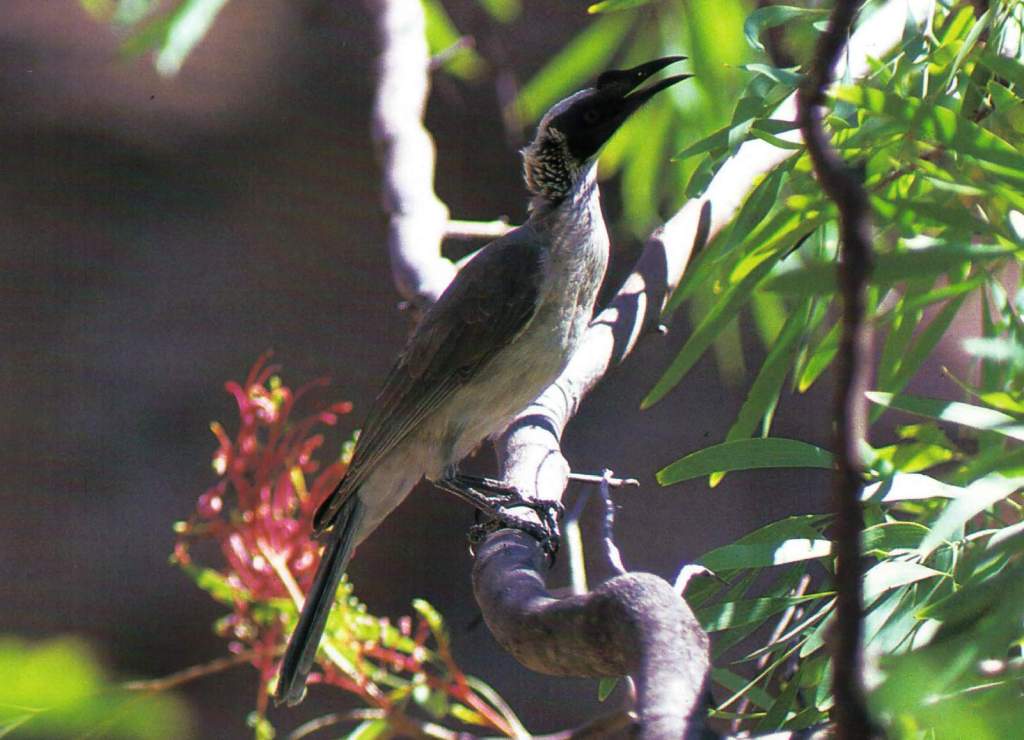Silver-crowned friarbird (Philemon argenticeps) rolling clank can be heard among the dawn choruses in tropical eucalypt forests and woodlands of far northern Australia. Meliphagidae is the family of this lovely bird.
Throughout Arnhem Land, the Kimberleys, and the Gulf of Carpentaria, it is the most common large honeyeater; however, on the Cape York Peninsula, where it resembles a different race with a smaller bill and overlaps the range of Noisy Friarbirds and Helmeted Friarbirds, it is more scarce and limited. In appearance, they resemble Helmeted Friarbirds but are smaller and paler and have a narrow stripe of silvery cream feathering across their heads.
Mostly found in eucalypts and paperbark Melaleuca, they dive into the upper foliage of trees and feed noisily by gleaning nectar from flowers, gleaning insects from bark, twigs, and leaves, and picking fruit.

As they sally out in short flights to capture insects in midair, they take a higher proportion of insects than helmeted friarbirds. The main food sources are beetles, grasshoppers, chafers, weevils, ants, wasps, mantids, and spiders. In loose groups, silver-crowned friarbirds gather in eucalyptus and paperbark flowering flushes to feed as other honeyeaters and lorikeets follow them.
Friarbirds are usually the loudest members of these gatherings, chasing poachers from their small feeding territories and clanking and chuckling often in advertisement. Sometimes they dive into rock pools, springs, and even garden sprinklers at Darwin to bathe, hitting the water and fluttering back to their perches without landing. This is also how they drink. Breeding occurs in isolated pairs when groups break up. Nests are generally built by females. However, young people are fed by both sexes. It is also observed that common koel parasitized its nest. It is also known as the silvery-crowned friarbird.
Silver-crowned Friarbirds are about 275–310 mm long. Both sexes are similar; males are larger. The forehead, crown, and heavily tufted nape of this animal are silver-white, while the side of the face is bare and the ear coverts are furry. Back, shoulders, and rump are mid-fawn-brown. Flight feathers and square tails are darker brown, paler below. The chin, throat and upper breast are silver-white with scaly feathering; belly vent and underwing coverts are plain fawn Eyes are red. Bill is black with a large oblong knob at the base of the upper mandible. Feet are dark slate-grey. The immature bird’s throat and breast are washed yellow, the mantle, shoulders, and rump flecked white, the bill casque smaller, and the eyes browner; juveniles before the first annual molt several months after fledging are more like adults, without yellow wash or white flecking, but fluffier.
Silver-crowned Friarbird’s call is metallic whistled clanking, softer than Helmeted Friarbird’s. The song consists of Raucous clanking more tobacco, uh-more tobacco, often in duet or antiphonally.
Nesting and breeding occur in September–December, sometimes later. Nest a bowl of strips of bark, bark fiber, and cobweb, lined with grass stalks and other plant matter; the rim of the nest is firmly woven over thick-forked branches, usually in drooping outer foliage 2–11 meters above ground. Eggs: one or two, rarely three; fine, matt pale pink to white, sparingly and vaguely spotted with pale sepia, purple-brown, and slate, often more at the larger end; tapered oval, about 30 x 21 mm. The incubation process is responsible for females.
As far as distribution is concerned, the silver-crowned friarbird is found in tropical eucalypt forests and paperbark Melaleuca open forests and close woodlands along the northern coast of the mainland, from Kimberley’s to the Cape York Peninsula. Nomadic, following flowering, may irrupt outside range in eastern Queensland. There are two races: one widespread, the other limited to the northern and eastern Cape York Peninsula.







